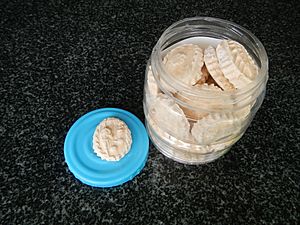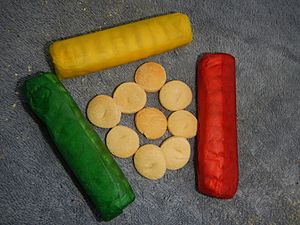Uraro facts for kids

Uraró cookies from Bataan
|
|
| Alternative names | araró, arrowroot cookies, arrowroot biscuits, galletas de Liliw |
|---|---|
| Type | Cookie |
| Place of origin | Philippines |
Uraró, also called araró or arrowroot cookies, are yummy Filipino cookies. They are made from a special flour called arrowroot flour. These cookies feel dry and powdery when you eat them. They often look like pretty flowers! Uraró cookies come from the southern part of Luzon island in the Philippines. They are especially popular in places like Laguna, Quezon, and Marinduque.
Contents
Where the Name Uraró Comes From
The name Uraró (or araró) comes from the plant it's made from. This plant is called maranta arrowroot. Its scientific name is Maranta arundinacea. The word uraró is the common name for this plant in both Tagalog and Spanish.
Sometimes, these cookies are also called galletas de Lilio. This is Spanish for 'Liliw biscuits'. They get this name from the town of Liliw in Laguna. Liliw is famous for making these delicious cookies.
How Uraró Cookies Are Made

Making traditional uraró cookies takes a lot of effort. It all starts with harvesting the arrowroot plants. The roots are carefully washed to remove dirt.
Making Arrowroot Flour
After washing, the roots are crushed. People use a stone on a hard wooden surface for this. This process is called pag-ilod. A liquid comes out from the crushed roots.
This liquid is then collected. It goes through a second step called pinapatining. Here, the liquid sits quietly. This allows the water to separate from the starch. The water is then poured away.
The starchy part is kneaded to squeeze out more water. Finally, this starch is dried. It is then sieved through a cloth called katsa (which is like muslin). This careful process makes the fine arrowroot flour. The whole flour-making process can take a full day!
Baking the Cookies
Once the flour is ready, it's mixed with other ingredients. These include melted lard, egg yolks from duck eggs, sugar, and milk. The mixture is then shaped into cookies.
These cookies are baked in a pugon. A pugon is a traditional Filipino clay oven. This old-fashioned way of baking gives the cookies their special taste.
Modern Uraró Making
Today, many uraró cookies are made a bit differently. They often use arrowroot flour, sugar, milk, and eggs. Instead of lard, people might use margarine or butter.
Sometimes, other flours like tapioca flour or rice flour are used. However, cookies made with these flours might not be as good. They might not melt in your mouth like traditional uraró. Some recipes also add coconut cream or maple syrup. These versions also taste a bit different.
What Makes Uraró Special
Uraró cookies are usually sold in tall, round stacks. They are wrapped in colorful crêpe paper, which is called papel de Japon.
Uraró cookies have a texture similar to another Filipino biscuit called puto seco. Both are powdery. However, uraró cookies are not as dry as puto seco. Uraró also has a lovely milky and buttery flavor that makes them unique.

